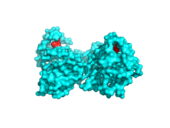Difference between revisions of "Fabry:Normal mode analysis"
Rackersederj (talk | contribs) (→WEBnm@) |
Rackersederj (talk | contribs) m (→ElNemo) |
||
| Line 236: | Line 236: | ||
<br style="clear:both"> |
<br style="clear:both"> |
||
| − | == |
+ | == ElNémo == |
<br style="clear:both"> |
<br style="clear:both"> |
||
Revision as of 12:21, 11 July 2012
Fabry Disease » Normal_mode_analysis
Contents
Introduction
Maybe one of the first questions that can be asked in this task is, why we use low-frequency normal modes. This is explained in the paper of Marc Delarue and Philippe Dumas<ref>Marc Delarue and Philippe Dumas On the use of low-frequency normal modes to enforce collective movements in refining macromolecular structural models, Proc. Natl. Acad. Sci. (USA), 101, 6957-6962 (2004)</ref>, where they claim, that "many of the structural transitions (...) can be explained by just a few of the lowest-frequency normal modes". The normal modes can be used to generate the general motion of a system by superposition them. Thus we could in principle infer from our analysis in this task how the alpha-galactosidase A, which we examine hydrolyses the terminal alpha-galactosyl moiety of its substrate<ref>Normal mode http://en.wikipedia.org/wiki/Normal_mode, July 5th, 2012</ref>.
Possible normal modes:
The structure 3HG2 has 781 C-alpha atoms in its pdb file, thus 781*3 - 6 = 2337 normal modes could be calculated in principle for this structure without any cutoff by elNémo. Since the structure has a total of 6765 atoms, 20289 NMs could be calculated by WEBnm@.
The structure 3HG3 has 793 C-alpha atoms in its pdb file, thus 793*3 - 6 = 2373 normal modes could be calculated in principle for this structure without any cutoff by elNémo. Since the structure has a total of 7537 atoms, 22605 NMs could be calculated by WEBnm@.
WEBnm@
WEBnm@ <ref>Hollup SM, Sælensminde G, Reuter N. WEBnm@: a web application for normal mode analysis of proteins BMC Bioinformatics. 2005 Mar 11;6(1):52 </ref> claim to administer simple and automated computation of low-frequency normal modes for proteins as well as their analysis in order to clarify if it is beneficial to perform a complete study on the protein in question.
The server calculates Normal Modes with the help of the MMTK package <ref>Hinsen K, The Molecular Modelling Toolkit: a new approach to molecular simulations, J Comput Chem, 21:79-85, 2000</ref>, which is an Open Source program library for molecular simulation applications. A C-alpha force field <ref>Hinsen K, Petrescu AJ, Dellerue S, Bellissent-Funel MC, Kneller GR, Harmonicity in slow protein dynamics, Chemical Physics, 261:25-37, 2000</ref> is used and only these C-alpha atoms are used, but with a weight assigned that corresponds to the masses of the whole residue they represent.
The server provides a bunch of analysis tools and all results can be downloaded without any problems. The tools are:
- deformation energies of each mode
- eigenvalues
- calculation of normalized squared atomic displacements
- calculation of normalized squared fluctuations
- interactive visualization of the modes using vector field representation or vibrations
- correlation matrix
<figtable id="tab:DeformationEnergies"> Deformation Energies 3HG2 and 3HG3: ADD CAPTION HERE
| Mode Index | Deformation Energy 3HG2 | Deformation Energy 3HG3 |
|---|---|---|
| 7 | 406.07 | 318.52 |
| 8 | 580.11 | 508.88 |
| 9 | 1062.04 | 1078.20 |
| 10 | 1703.56 | 1621.95 |
| 11 | 1808.92 | 1827.08 |
| 12 | 2227.10 | 2019.97 |
| 13 | 2541.59 | 2481.89 |
| 14 | 3109.43 | 2695.35 |
| 15 | 3345.86 | 3321.12 |
| 16 | 3842.69 | 3588.18 |
| 17 | 4868.07 | 3782.94 |
| 18 | 5178.29 | 4404.61 |
| 19 | 6119.79 | 5349.94 |
| 20 | 5940.89 | 6027.59 |
</figtable>
Mode Visualization
<figtable id="tab:webnma_3hg2">
In this table are the 6 modes shown, that were calculated by WEBnm@. Depicted is the structure 3HG2, which represents the Human α-galactosidase catalytic mechanism with empty active site in cyan and the substrate binding site at position 203 to 207 highlighted in red.
</figtable>
<figtable id="tab:webnma_3hg3"> In this table are the 6 modes shown, that were calculated by WEBnm@. Depicted is the structure 3HG3, which represents the Human α-galactosidase catalytic mechanism with bound substrate (green, α-D-Galactose with bound α-D-Glucose) in cyan and the substrate binding site at position 203 to 207 highlighted in red.
</figtable>
Average Energies
<figtable id="tab:AverageEnergies"> ADD CAPTION HERE
| 3HG2 | 3HG3 |
|---|---|
| 406.07 | 318.52 |
| 580.11 | 508.88 |
| 1062.04 | 1078.20 |
| 1703.56 | 1621.95 |
| 1808.92 | 1827.08 |
| 2227.10 | 2019.97 |
| 2541.59 | 2481.89 |
| 3109.43 | 2695.35 |
| 3345.86 | 3321.12 |
| 3842.69 | 3588.18 |
| 4868.07 | 3782.94 |
| 5178.29 | 4404.61 |
| 6119.79 | 5349.94 |
| 5940.89 | 6027.59 |
</figtable>
Atomic Displacement Analysis
<figure id="fig:atomDisplacement3HG2">
</figure> <figure id="fig:atomDisplacement3HG3">
</figure>
Plots the displacement of each Calpha atom, i.e. highlights which parts of the protein are the most displaced for each mode.
Correlation Matrix
Plots the correlation of motions between all the Calphas in the protein structure.
Overlap Analysis
General error. A trouble ticket has already been send on 04.07.2012 11:22
ElNémo
References
<references/>




















